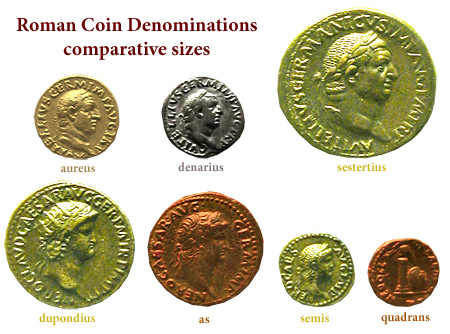

Policies regarding coinage changed frequently during the Republic, especially during the chaotic last century marked by nearly constant civil wars. About 23 BCE, Augustus reformed and stabilized the coinage system and established the major denominations that would persist for centuries and give all the peoples in the Mediterranean region a common currency (a feat not equaled until the euro of the European Union). He adapted two earlier coins used during the Republic as full-value coins based on their precious metal content--the gold aureus and the silver denarius. He also introduced three base-metal coins (called "fiduciary" or "token" coins because their value was assigned by the government rather than based on their metal content)--the sestertius and dupondius, made of an alloy of copper and zinc called "orichalcum," and the as, made of copper; later Nero added the orichalcum semis coin. The value of all these coins was linked to the copper as, representing 1 unit of value. The dupondius was 2 asses; the sestertius, 4 asses; the denarius, 4 sestertii or 16 asses; and the aureus, 25 denarii or 400 asses (see this diagram of coin valuations; the above image illustrates the relative size of these coins). Augustus was very clever in choosing orichalcum brass for the sestertius and dupondius, because their attractive shiny yellow color helped convince the people of their value. Because the dupondius and the as were similar in size, after Nero the convention developed of depicting the emperor on the obverse of the dupondius with a radiate crown (the spikes of the crown represent the rays of the sun god), while the emperor on the as wore a laurel-leaf crown; this helped users to distinguish the two coins more easily, since the dupondius was twice the value of the as.
Over the centuries after Augustus emperors debased the precious metal content of the aurei and denarii and the weight of the coins several times, but the relative values of all the coins were preserved until major changes in coinage in the early third century CE.
In VRoma, as in antiquity, Romans conduct most daily transactions using base-metal coins, but they go to the moneychangers (nummularii) on the Clivus Argentarius to exchange these for denarii and aurei for their savings. The sestertii, dupondii, and asses are large and heavy, but the denarii and aurei are small, beautiful, and easily stored or transported. Because of inflation, in VRoma the lowest denomination is the as; the fractional semis and quadrans are no longer in use.